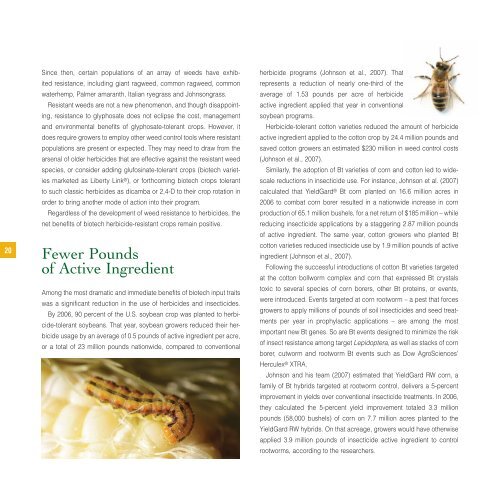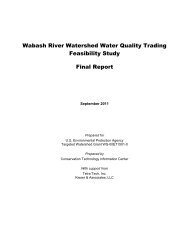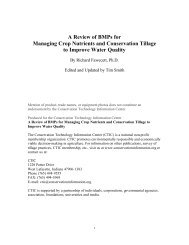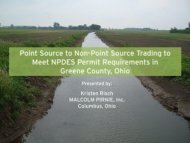Facilitating Conservation Farming Practices and Enhancing ...
Facilitating Conservation Farming Practices and Enhancing ...
Facilitating Conservation Farming Practices and Enhancing ...
Create successful ePaper yourself
Turn your PDF publications into a flip-book with our unique Google optimized e-Paper software.
20<br />
Since then, certain populations of an array of weeds have exhibited<br />
resistance, including giant ragweed, common ragweed, common<br />
waterhemp, Palmer amaranth, Italian ryegrass <strong>and</strong> Johnsongrass.<br />
Resistant weeds are not a new phenomenon, <strong>and</strong> though disappointing,<br />
resistance to glyphosate does not eclipse the cost, management<br />
<strong>and</strong> environmental benefits of glyphosate-tolerant crops. However, it<br />
does require growers to employ other weed control tools where resistant<br />
populations are present or expected. They may need to draw from the<br />
arsenal of older herbicides that are effective against the resistant weed<br />
species, or consider adding glufosinate-tolerant crops (biotech varieties<br />
marketed as Liberty Link ® ), or forthcoming biotech crops tolerant<br />
to such classic herbicides as dicamba or 2,4-D to their crop rotation in<br />
order to bring another mode of action into their program.<br />
Regardless of the development of weed resistance to herbicides, the<br />
net benefits of biotech herbicide-resistant crops remain positive.<br />
Fewer Pounds<br />
of Active Ingredient<br />
Among the most dramatic <strong>and</strong> immediate benefits of biotech input traits<br />
was a significant reduction in the use of herbicides <strong>and</strong> insecticides.<br />
By 2006, 90 percent of the U.S. soybean crop was planted to herbicide-tolerant<br />
soybeans. That year, soybean growers reduced their herbicide<br />
usage by an average of 0.5 pounds of active ingredient per acre,<br />
or a total of 23 million pounds nationwide, compared to conventional<br />
herbicide programs (Johnson et al., 2007). That<br />
represents a reduction of nearly one-third of the<br />
average of 1.53 pounds per acre of herbicide<br />
active ingredient applied that year in conventional<br />
soybean programs.<br />
Herbicide-tolerant cotton varieties reduced the amount of herbicide<br />
active ingredient applied to the cotton crop by 24.4 million pounds <strong>and</strong><br />
saved cotton growers an estimated $230 million in weed control costs<br />
(Johnson et al., 2007).<br />
Similarly, the adoption of Bt varieties of corn <strong>and</strong> cotton led to widescale<br />
reductions in insecticide use. For instance, Johnson et al. (2007)<br />
calculated that YieldGard ® Bt corn planted on 16.6 million acres in<br />
2006 to combat corn borer resulted in a nationwide increase in corn<br />
production of 65.1 million bushels, for a net return of $185 million – while<br />
reducing insecticide applications by a staggering 2.87 million pounds<br />
of active ingredient. The same year, cotton growers who planted Bt<br />
cotton varieties reduced insecticide use by 1.9 million pounds of active<br />
ingredient (Johnson et al., 2007).<br />
Following the successful introductions of cotton Bt varieties targeted<br />
at the cotton bollworm complex <strong>and</strong> corn that expressed Bt crystals<br />
toxic to several species of corn borers, other Bt proteins, or events,<br />
were introduced. Events targeted at corn rootworm – a pest that forces<br />
growers to apply millions of pounds of soil insecticides <strong>and</strong> seed treatments<br />
per year in prophylactic applications – are among the most<br />
important new Bt genes. So are Bt events designed to minimize the risk<br />
of insect resistance among target Lepidoptera, as well as stacks of corn<br />
borer, cutworm <strong>and</strong> rootworm Bt events such as Dow AgroSciences’<br />
Herculex ® XTRA.<br />
Johnson <strong>and</strong> his team (2007) estimated that YieldGard RW corn, a<br />
family of Bt hybrids targeted at rootworm control, delivers a 5-percent<br />
improvement in yields over conventional insecticide treatments. In 2006,<br />
they calculated the 5-percent yield improvement totaled 3.3 million<br />
pounds (58,000 bushels) of corn on 7.7 million acres planted to the<br />
YieldGard RW hybrids. On that acreage, growers would have otherwise<br />
applied 3.9 million pounds of insecticide active ingredient to control<br />
rootworms, according to the researchers.








